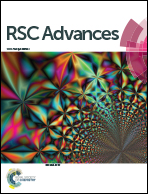A comparative study on the physico–chemical properties of sol–gel electrospun cobalt oxide nanofibres from two different polymeric binders†
Abstract
In this study, two different sacrificial polymeric binders, namely poly(2-ethyl-2-oxazoline) (PEtOx) and poly(styrene-co-acrylonitrile) (SAN) along with cobalt acetate tetrahydrate (CATH), as the metal oxide precursor, were used for the fabrication of Co3O4 nanofibres through sol–gel electrospinning. It was observed that the degradation behaviour and physical properties of SAN and PEtOx influenced the structure, morphology and spectral properties of Co3O4 nanofibres, as the properties of the nanofibres obtained from the aforementioned systems were compared with each other. The grain size, shape and the activation energies for grain growth of Co3O4 nanofibres obtained from these two polymeric systems were different. This difference in grain size and shape caused a difference in the optical band gap energies and the magnetic properties of the Co3O4 nanofibres. This study reveals that one can tailor the characteristics of cobalt oxide nanofibres by an appropriate selection of polymeric binders for sol–gel electrospinning.


 Please wait while we load your content...
Please wait while we load your content...